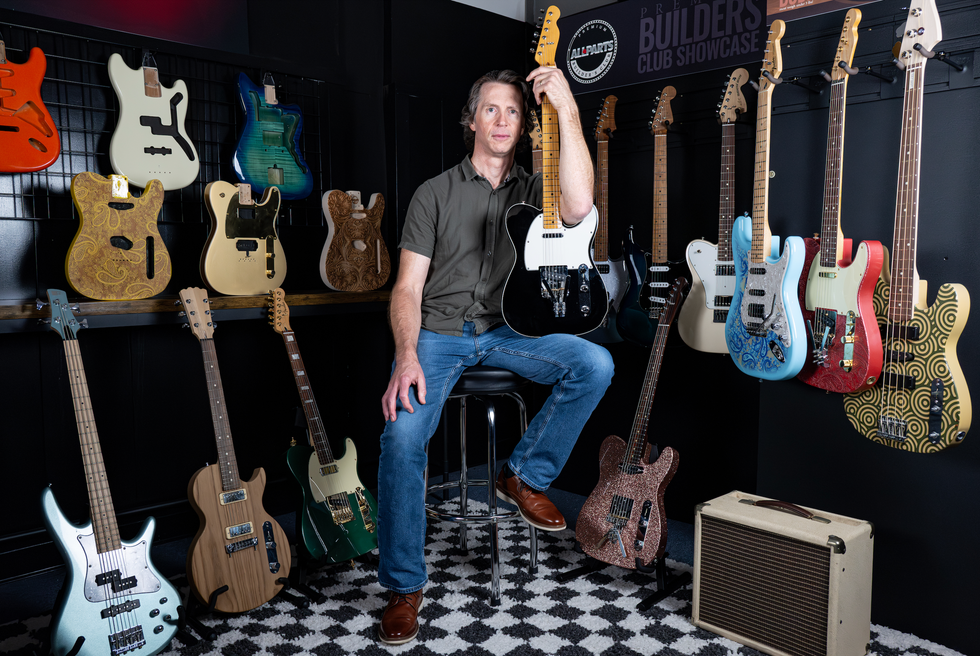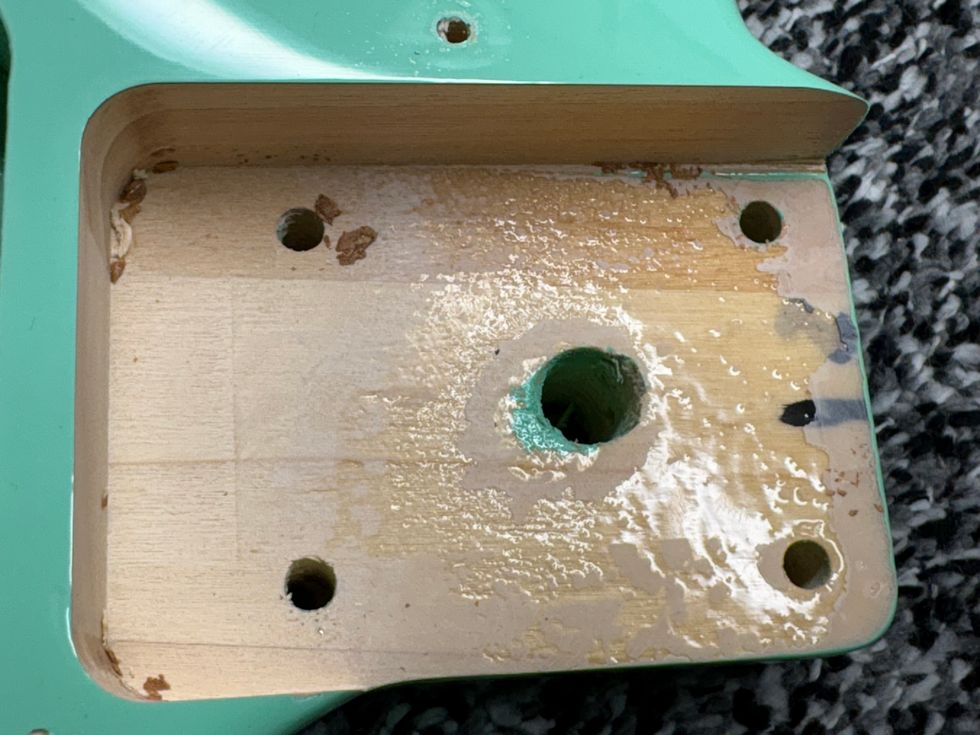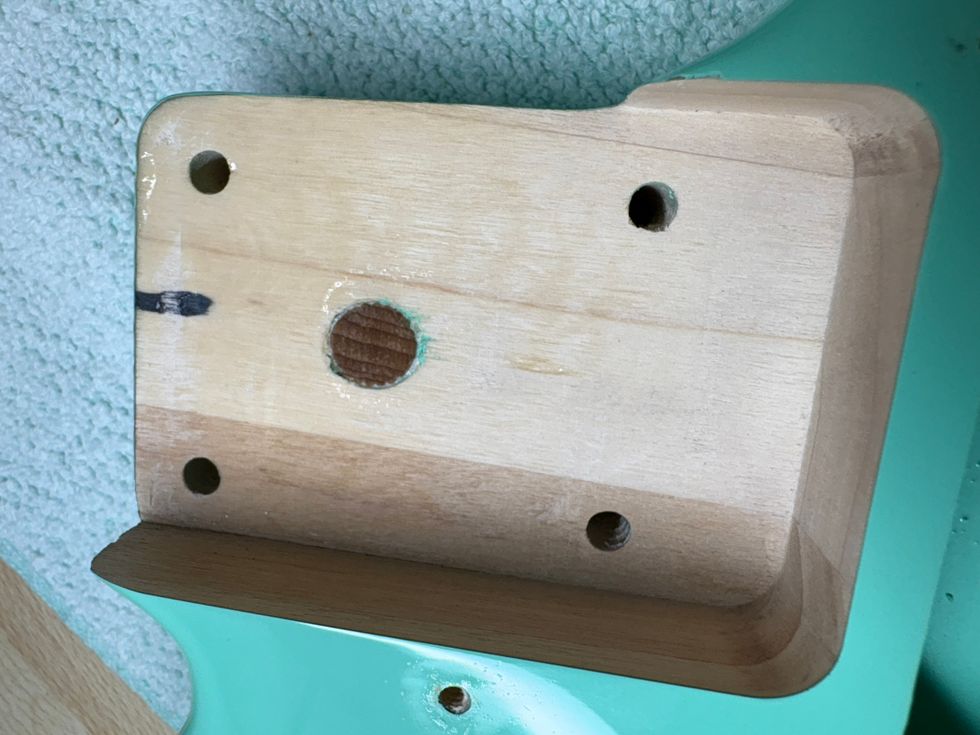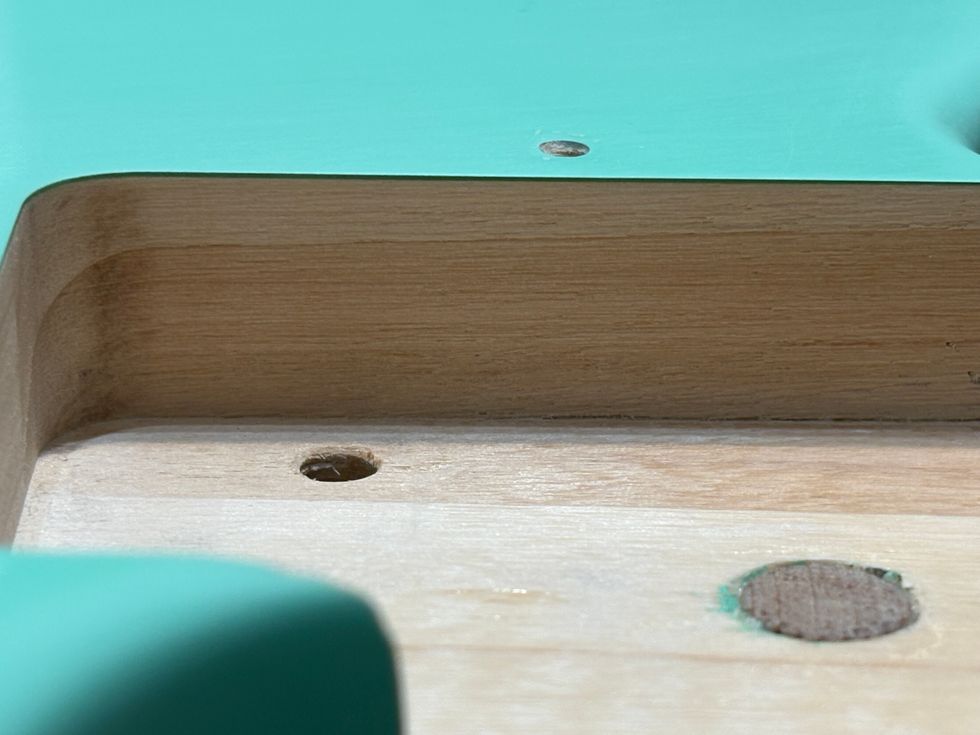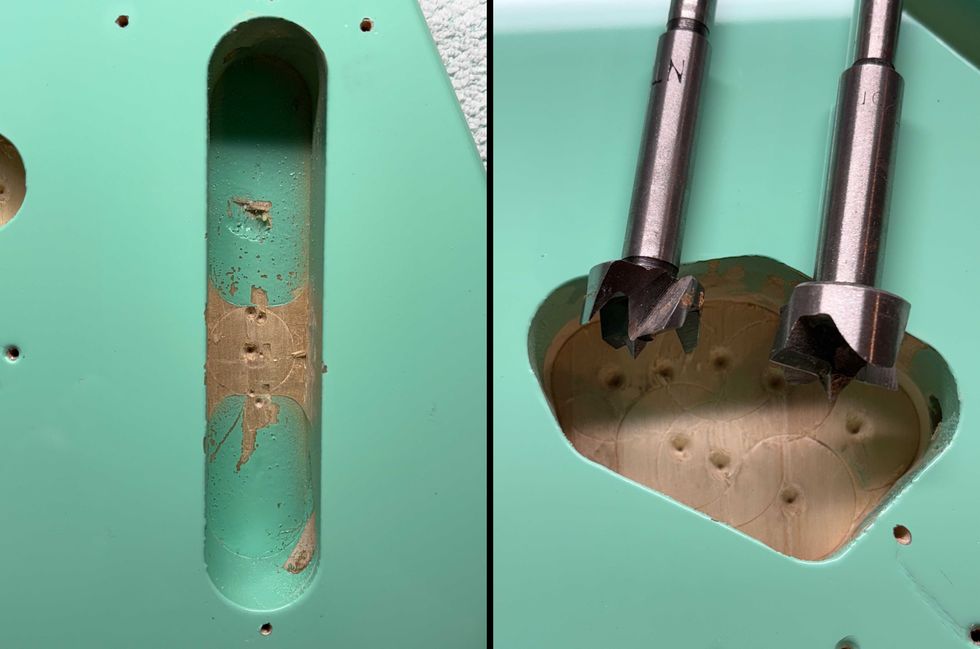Band lineups change. Sometimes egos get in the way and musicians quit in acrimony and bitterness. Sometimes guitar players simply want a change of pace. And other times, tragic circumstances force difficult decisions. Such was the case in late 1982 when a young San Francisco Bay Area guitarist was invited to audition for a pretty big band. Originally, he thought the outlandish offer had to be a practical joke. However, after woodshedding on 18 songs for two days, he flew to New York and made his way to a luxurious suite in the Helmsley Palace Hotel. He played some of rock music’s most famous riffs on a red ’62 Fender Stratocaster—without an amp—while a British heavy metal legend sat cross-legged on the floor, watching his intricate solo. Then the Brit jumped up and hugged him.
And that’s how Brad Gillis assumed the guitar duties for Ozzy Osbourne after the legendary Randy Rhoads perished in a tragic plane crash.
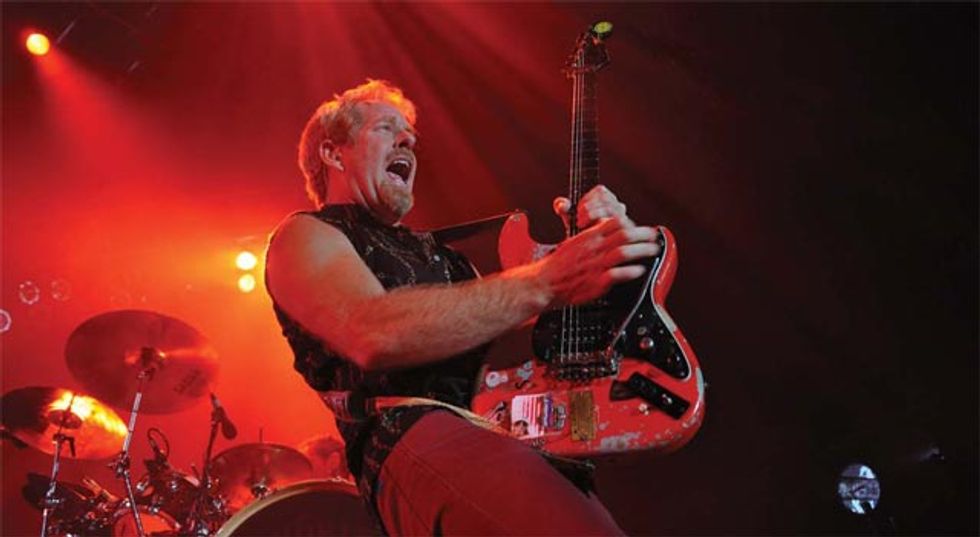
Brad Gillis onstage with Night Ranger and his battered ’62 Strat, which is equipped with an original Floyd Rose tremolo. Gillis first found fame when he was tapped to replace Randy Rhoads in Ozzy Osbourne’s band.
There are countless stories like Gillis’, stories of previously unknown players getting their chance at some measure of fame and glory while filling the shoes of better-known guitarists who’ve moved on for one reason or another. But while these opportunities are in many ways a dream come true for the replacement axe men, their high-profile new gigs aren’t without their unique and sometimes frustrating challenges. To get a sampling of those challenges, we spoke with Gillis, Guns N’ Roses’ Ron Thal, Kiss’ Tommy Thayer, L.A. Guns’ Stacey Blades, and Dokken’s Jon Levin.
Lacing Up
Ozzy initially tapped Irish guitarist Bernie Tormé to fill in after Rhoads’ death, but his sound and style was deemed too different for the Prince of Darkness. After a few days of observing Tormé perform with the band, Gillis plugged in and took over.
“I had never played with the band, never rehearsed with the band, and there was my first show—sold out, to 8000 people in Binghamton, New York,” Gillis recalls. Today, he’s preparing for a big summer tour with his band Night Ranger, which is perhaps best known for the huge 1984 power ballad “Sister Christian.” Gillis says last year was one of the band’s best ever and that they anticipate building on that success with as many as 70 tour stops in 2010. But Gillis originally cemented his shredder reputation with that challenging stint with Ozzy back in ’82.
Whenever a new guitarist comes in and has to play classic tunes, the fans sit back and start speculating. Will the new guy totally change everything in an attempt to put his own stamp on things? Or, will he simply mimic the original runs and bring nothing new or different to the table? For the musician in question, it can seem like an unwinnable situation.
“It was quite a trying experience and the first two weeks were really tough for me,” Gillis says. “A lot of the fans weren’t expecting me and were giving me that look like, ‘Let’s see what you can do.’ I had guys in the audience flipping me off, holding up ‘Randy Rhoads lives’ signs, and just giving me that look.”
Stacey Blades of L.A. Guns has the difficult task of performing in a band that carries his predecessor’s name. He joined the group in 2003 and set out to win over fans by performing the songs and solos as they were originally recorded by Tracii Guns. His choice to honor the original music was not only out of respect for the audience but also his own personal tastes and interests.
“As a fan of the band, I wanted to learn those leads like they are on the record,” Blades says. “I wouldn’t play it any other way.” He says that after seven years in the band, he seldom receives negative feedback from concertgoers today. Rarely, a person shows up to a gig expecting the original Tracii Guns, but Blades strives to win them over.
“I had to tell a guy in Laughlin, Nevada, that I’m not Tracii,” Blades says of a recent gig. “He got this confused look on his face and said, ‘You still rock, bro.’”
If Blades rocks in a band named for the guy he replaced, at least he gets to wear his own footwear. For current Kiss guitarist Tommy Thayer, the adage about filling in someone’s shoes is literal. After working in various capacities with the Kiss organization for years, Thayer officially assumed the role of the Spaceman in 2003 when he donned the costume made famous by original guitarist Ace Frehley. After a few smaller gigs the preceding year, Thayer’s first real show with the face-painted rockers was with the Melbourne Symphony Orchestra in Australia. That concert involved 70 additional musicians and different song arrangements, and it was also recorded for CD and DVD releases.
“It was a really diverse set with a lot going on,” Thayer says. “That was playing on my nerves more than anything, but I got through it and it turned out just great.”
Since that initial introduction in the silver platform boots, Thayer has performed hundreds of Kiss gigs across the globe. In some ways, he is arguably one of the most controversial guitar players in rock music. Any reference to him and Kiss on the Internet elicits a stream of comments from people who either criticize the slightest difference between his work and Frehley’s or write him off as a carbon copy.
“I have so much respect for that guy,” says Guns N’ Roses guitarist Ron Thal. “Because to be in the most legendary band, to be in such a situation, and have the strength of character he must have to be able to do it.”
Ultimately, all replacement rockers have to soldier on, shred as much as possible, and just keep working to win over the audience. Ignoring internet trolls, playing as well as possible, and remaining committed to the gig are the prescribed tasks for guitarists taking over for a departed legend.
“It’s going to be tough at first, and you’ve got to have thick skin and take your lumps,” says Thal. “You have to stop reading your email and stop Googling your name. My advice is always, ‘Don’t do it for the people that don’t like it. You have to do it for the people who do.’”
Dedication pays off, says Jon Levin, who cranks out sizzling leads associated with George Lynch for Dokken. “With time and persistence, you can change people’s minds and win over fans.”
It’s a Rock Thing
The argument can be made that the audience’s obsession over the guitarist in the spotlight and his approach to trademark tunes is uniquely tied to the rock and heavy metal genres. Few hepcats in a jazz club are going to sneer, “He didn’t play that Miles Davis solo note.”
And no classical fan is going to go the other direction and accuse the third chair violin player of being a Paganini clone.
“It’s so bombastic and there are so many variations, as far as rock artists go. I think it’s the whole package thing,” Blades says in regards to the passion with which fans view their favorite guitarists. “That’s why people hold it so dear and debate band combinations as opposed to a symphony or orchestra.” Few things are more hotly debated among fans than replacement band members.
An orchestra can have as many as 100 musicians, all dressed similarly, all sitting down, partially hidden behind music stands and instruments. And jazz outfits frequently feature guest artists, change lineups, and have other musicians jam on different songs.
“In rock, you have a more personal connection to the artists and who the artist is as a person,” Thal says. “It’s about the person. And because of that, you start feeling a relationship and a loyalty to that person.” The music and the licks are connected to that guitarist, the image of them performing is burned into the fans’ memories.
Thayer expresses a similar sentiment. “It just seems that, with rock and roll bands in particular, people just seem to care that much more about what goes on,” he says. “It’s a very emotional thing, really. It’s almost a religious thing or a cultish thing to a lot of people, and they live their lives by a band like Kiss. I can understand why people feel that way.”
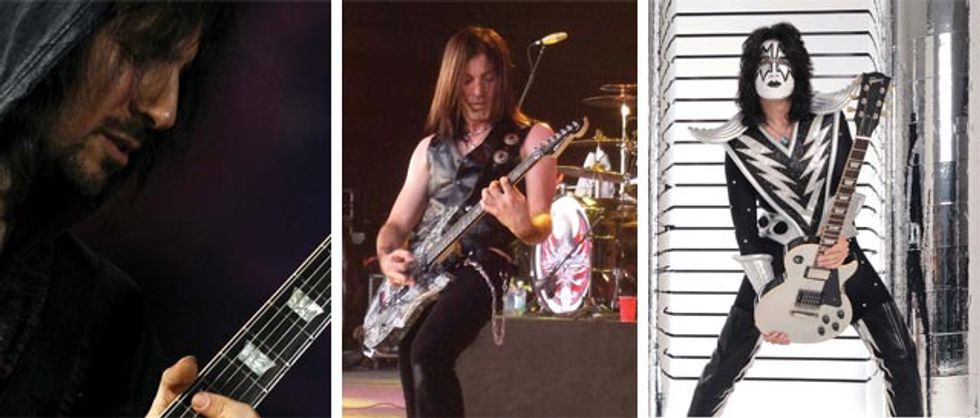
LEFT: Ron Thal took on the daunting task of filling Slash’s shoes in Guns N’ Roses. Photo by Chad Batka MIDDLE: Jon Levin and his Charvel now take care of the duties once executed by George “Mr. Scary” Lynch in Dokken. Photo by Jeff Findley RIGHT: Former Ace Frehley guitar tech Tommy Thayer now wears the Spaceman outfit onstage with Kiss. Photo by Glenn La Ferman
To Cop or Not to Cop? That is the Question
In spite of the audience’s fear that new axe slingers will trash all the licks and leads they hold dear, the consensus amongst replacement guitar players themselves seems to be that they should remain true to the original recordings.
“Primarily, the approach I take is to play the songs the way they were originally written and recorded,” says Thayer as Kiss prepares to depart for a sold-out European tour.
“That’s the way I like it and the way I want to hear it if I’m seeing another band that had a new guitarist come in.”
While most the guitar players we talked to for this article prefer to honor the originals, each musician does have varying degrees of alterations they’re willing to make. In short, it’s about being respectful without being slavish. A few slight changes are acceptable, if judiciously applied.
“You want to show respect to the song as it was written, as it was successful, in the way people have grown to love the song,” says Thal. However, there may be room within the context of the show for the guitarist to introduce some differences. “If it’s ‘Paradise City,’ you’re certainly not going to change that main hook. But when it comes to the long solo at the end of the song—not the part that people are humming and singing—it’s okay to take some liberties.”
During his tenure with Ozzy, Gillis found a few opportunities during the show to stretch out, too. “I wanted to interject a little of my style here and there throughout the set,” Gillis says. “I tried to stay close to Randy’s classic solos, but then each of us in the band had our individual solos every night, so I was able to do my whammy-bar thing.”
Interestingly enough, not one single guitarist interviewed for this article was told to play a certain way. When they auditioned and during their tenure, they were largely given free reign.
“No, not once did Axl Rose ever tell me how to play,” says Thal.
“I was never told what I had to play,” Gillis agrees.
“Don [Dokken] never told me what to do in any way, shape, or form,” says Levin.
Rethinking Rigs As guitarists strive to settle into an established band and replace an icon, they must make a choice about changing their equipment or sticking with what they’ve previously used.
For Thal, his initial introduction into Guns N’ Roses required a few equipment changes. Famous for the unique Vigier guitars he uses at his solo shows, Thal had to add some classic gear when he hit the stage with GNR.
“When I switched my gear up and got things closer to what they should be, it made a big difference to people,” Thal says. “Now, I get no complaints—like in the past when I was using a guitar shaped like a foot.”
Other musicians require less alteration. Levin, a Charvel endorsee, has always played so-called “super Strats” that provide tones and capabilities like those associated with George Lynch. Blades favors B.C. Rich guitars that fall in line with the classic Sunset Strip sleaze-metal tones.
Thayer already played Gibson Les Pauls, just as Frehley did, so none of his gear needed to be updated. However, a select few songs required alterations because of equipment differences. He points to songs from the ’80s, when former Kiss guitarists Vinnie Vincent and Bruce Kulick were employing new techniques and new instruments, as examples of tunes that required adjustment.
“We’re talking about Charvels and Jacksons with a whammy bar,” Thayer says. “There’s a little disconnect between that and the classic approach to Kiss, which is what we are today. Sometimes I do have to adapt it to playing a Les Paul as opposed to a Strat with a Floyd Rose.”
A Chance to Make a Mark
As replacement guitarists tour the country playing their predecessor’s tunes—even when it’s been over the course of many years—it can still feel like a temporary gig. But the opportunity to record with the band offers a chance to solidify their standing.
Up until the recording and release of Guns N’ Roses’ 2008 album, Chinese Democracy, Thal says he felt like he was “just being a gracious guest.” It wasn’t so much that fellow band members viewed the guitarist in a less-than-permanent way, but rather the public’s attitude.
“You could be best friends with the guys in the band and do everything that a band does, but for the whole world, truth is perception,” he says. “If the world perceives you as just some fill-in guy, it’s tough to continually disassociate yourself with everybody’s reality and live in your own. But once the album came out, it’s like, ‘All right—this is mine now!’”
For Thayer, the release of Sonic Boom, the first Kiss studio album in a decade, marked a milestone in his own identity as a musician.
“It’s a big stepping stone for me, in terms of my place in the band and my identity,” he says. “This last year and this year—coming into an era of me writing and singing and playing guitar on a new Kiss record that’s been received so well— that’s been a great step for me.”
A Walk to Remember
The musicians quoted here give the impression that playing someone else’s music isn’t as big a deal as the fans imagine. While message boards may light up with arguments over the new guy’s approach to the classic material or whether someone will fit in with the band, the guitarists simply play.
“I don’t need to have written something or recorded something to enjoy playing it,” says Thal. “I enjoy making music with people, and it doesn’t matter where the music originated. We’re doing it right now, and we’re having a great time—and people are having a great time with us.”
You may not have to replace an icon on short notice. But joining an established band in your hometown can still be a stressful situation. Here are some tips to help you pull it off.
• Be prepared for the audition. Know the music, be confident—but not cocky— and focus on establishing chemistry with the other band members. “Everybody plays guitar well to a certain degree, but I think the personalities, how you get along, and how you work together and interact is huge,” says Thayer. “People underestimate that.”
• Ease your way into the classic tunes. The fans will expect to hear the songs played a certain way. Do it that way at first. Over time, you can stretch out a bit. “At least in the beginning, don’t shake things up too much,” says Levin. “As you get more established, you can start deviating more and more.”
• Find a mentor or confidante in the band. Gillis explains, “I would go to [bassist] Rudy Sarzo and he’d say, ‘You’re doing a great job, don’t worry about it.’”
• Plow forward. Be confident in your work and accept the fact that you’re not going to please everyone. “If someone doesn’t like it, it just means that it’s not for them,” says Thal. “It’s not their taste and they can go and find something else that they like.”
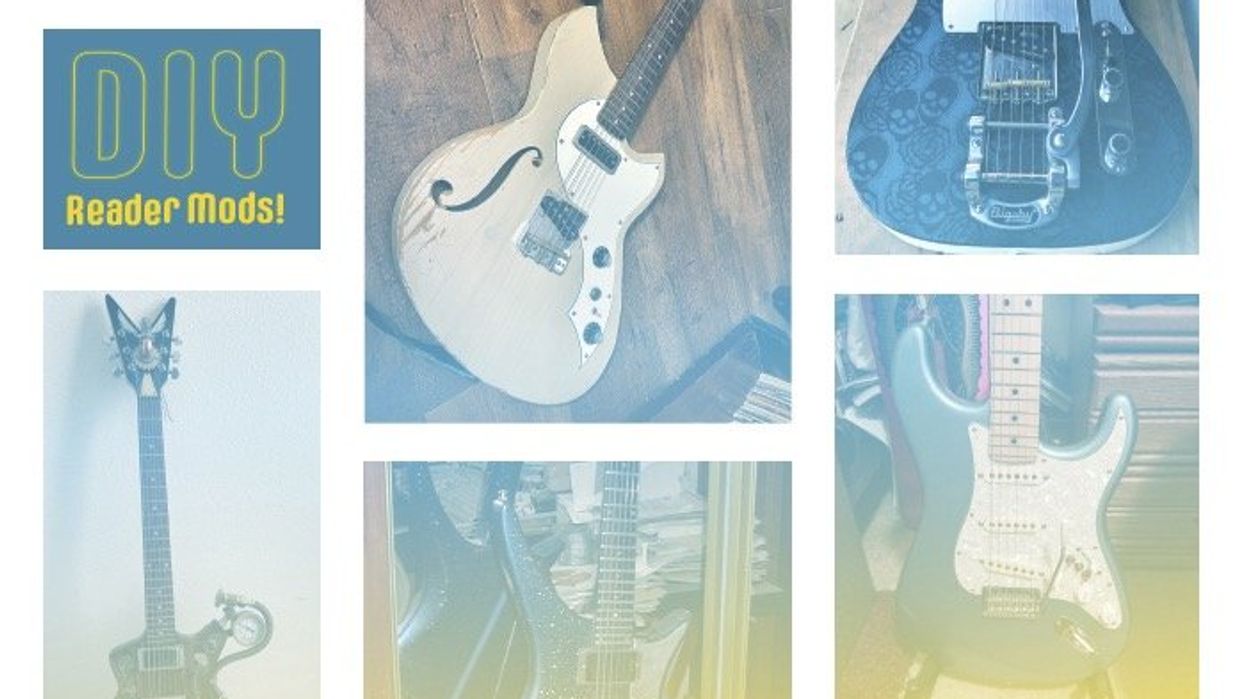
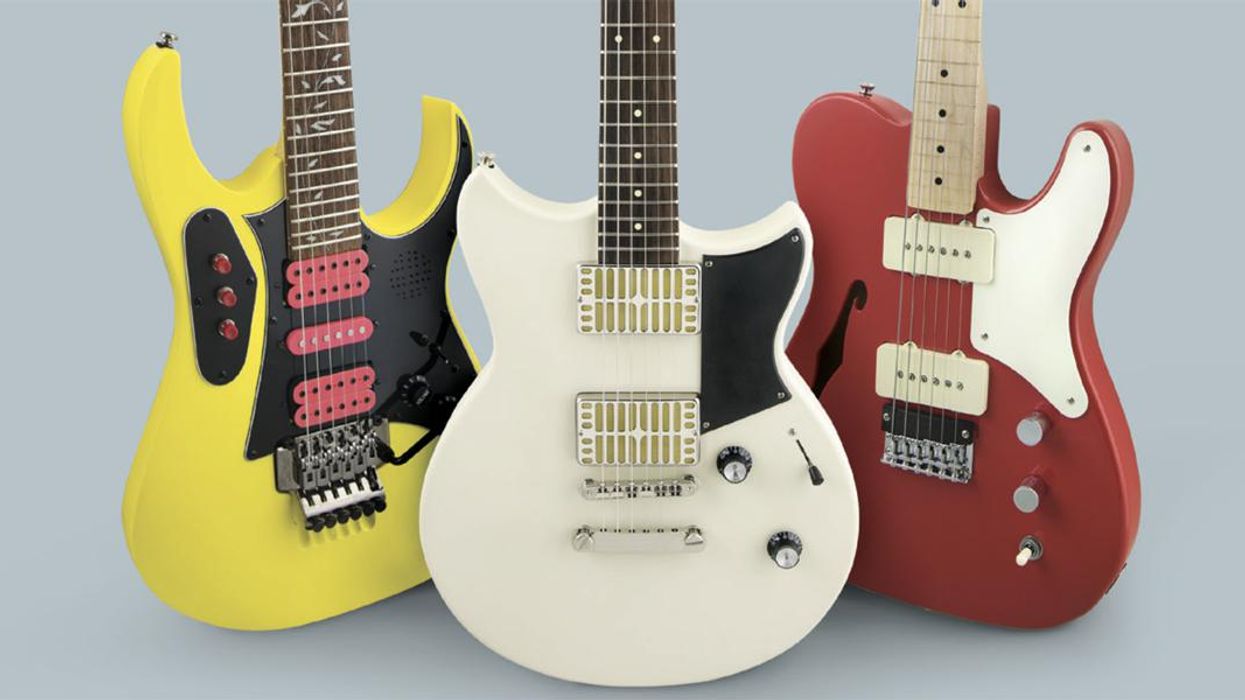
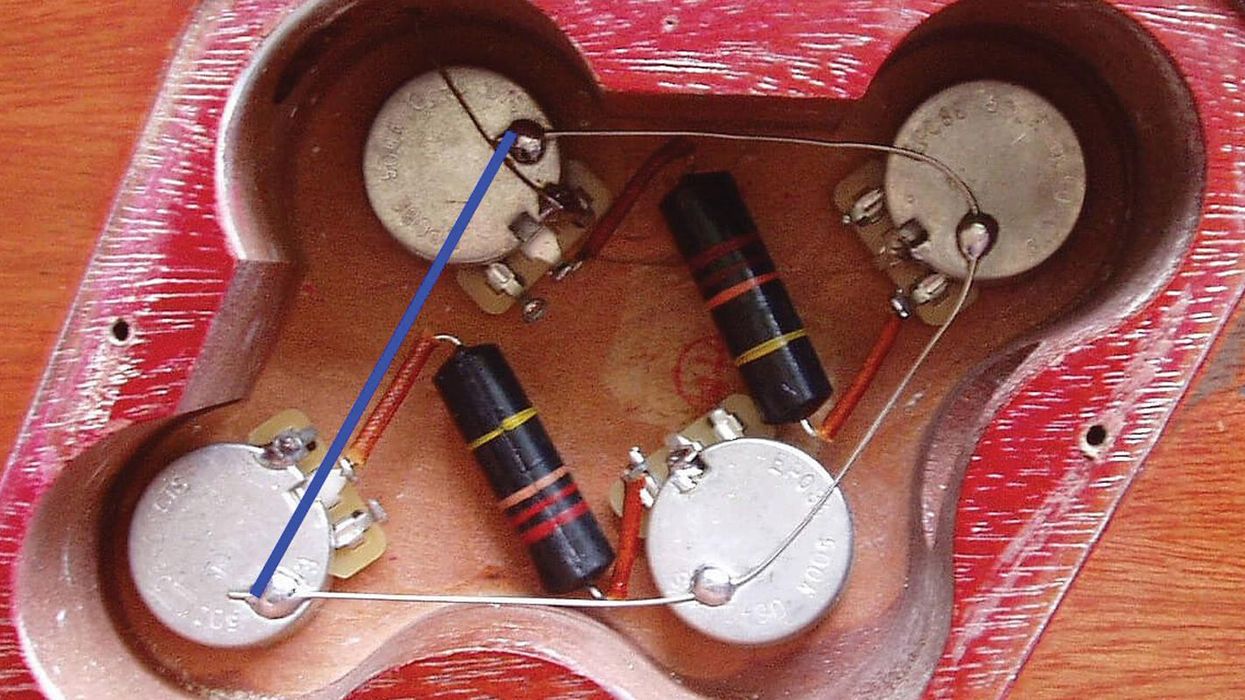
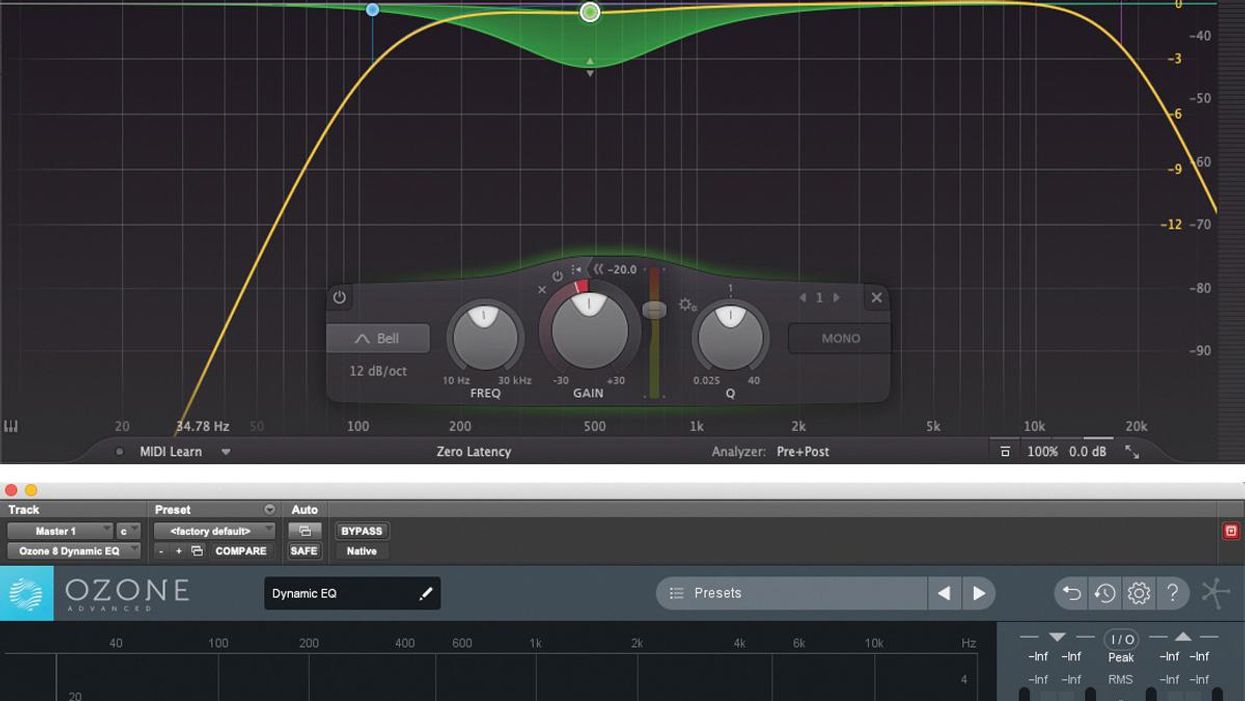


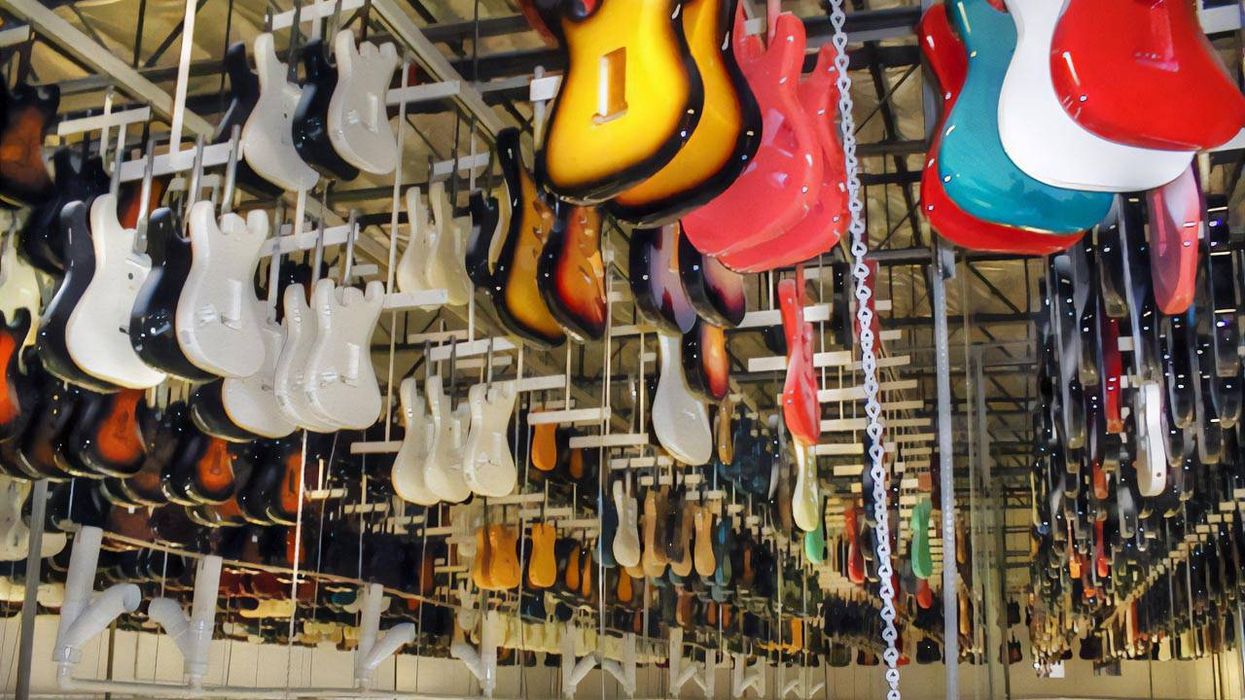


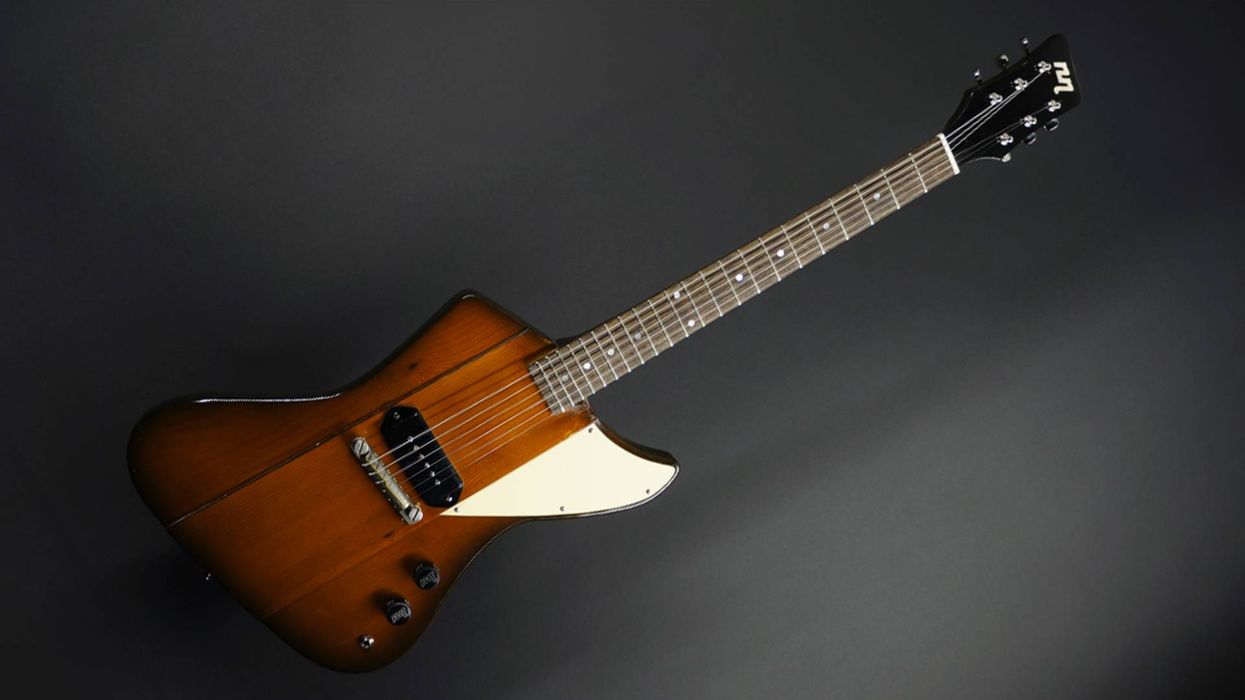


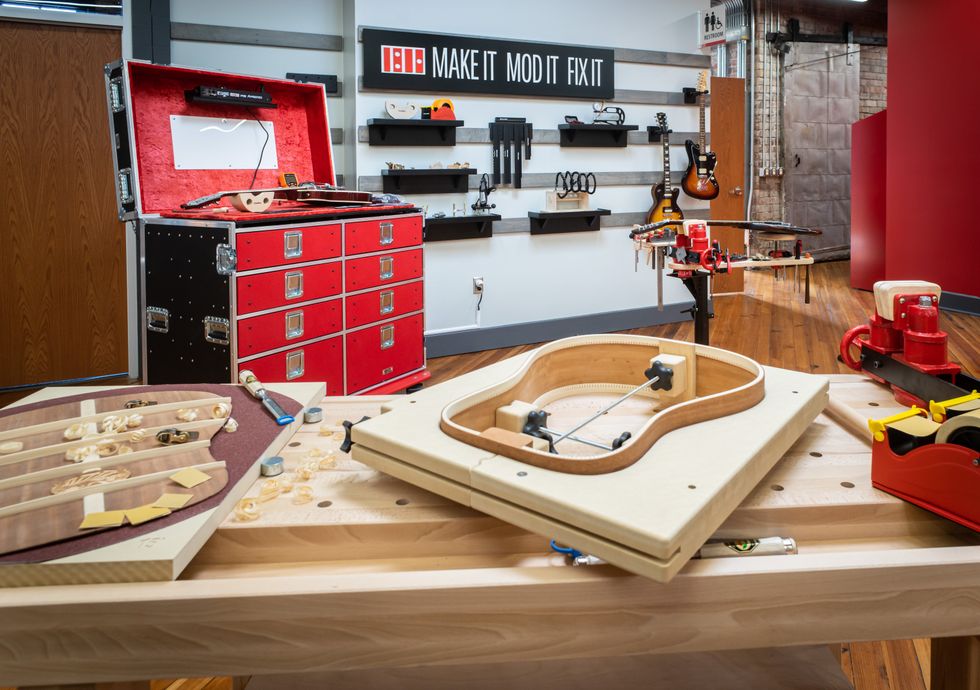
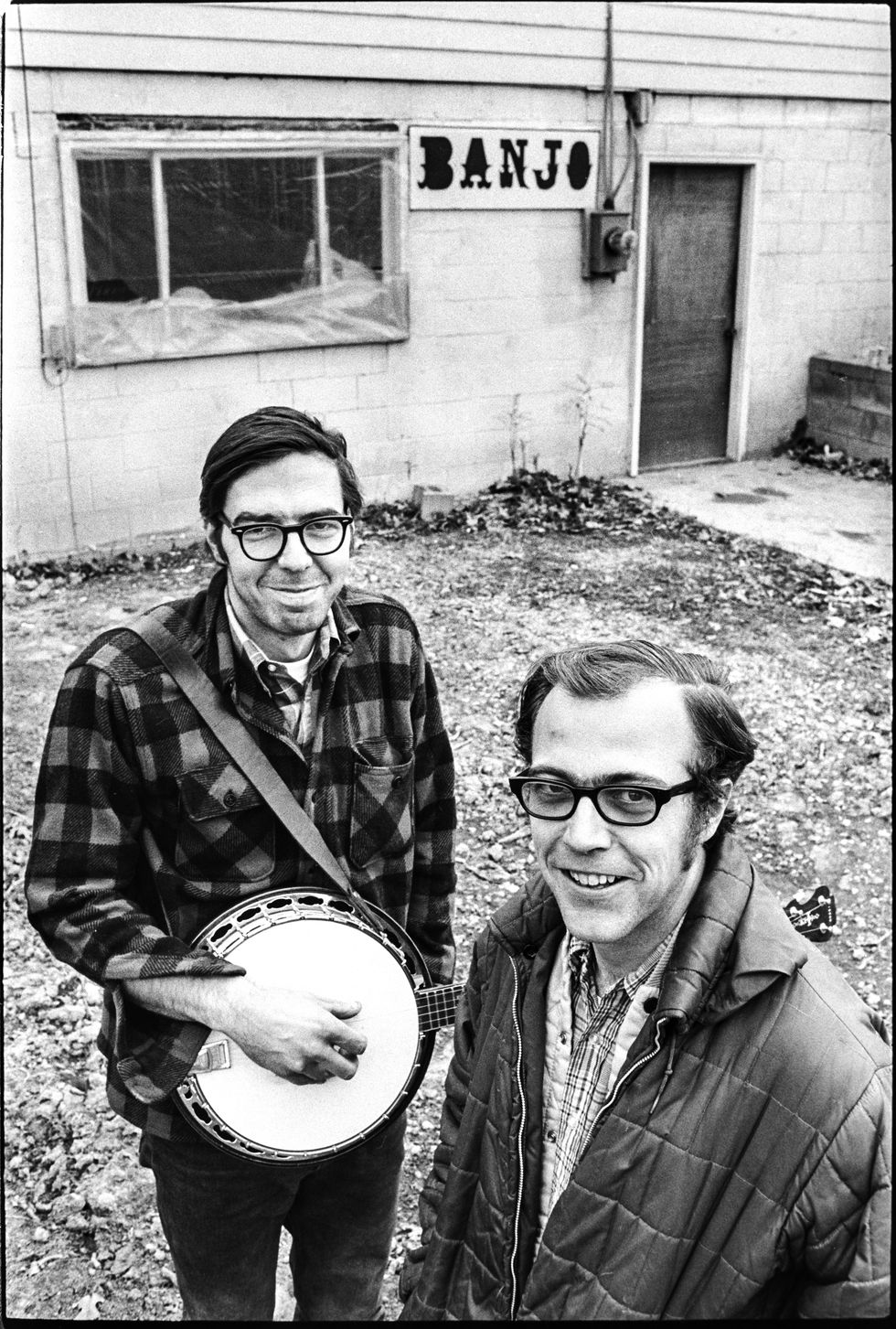
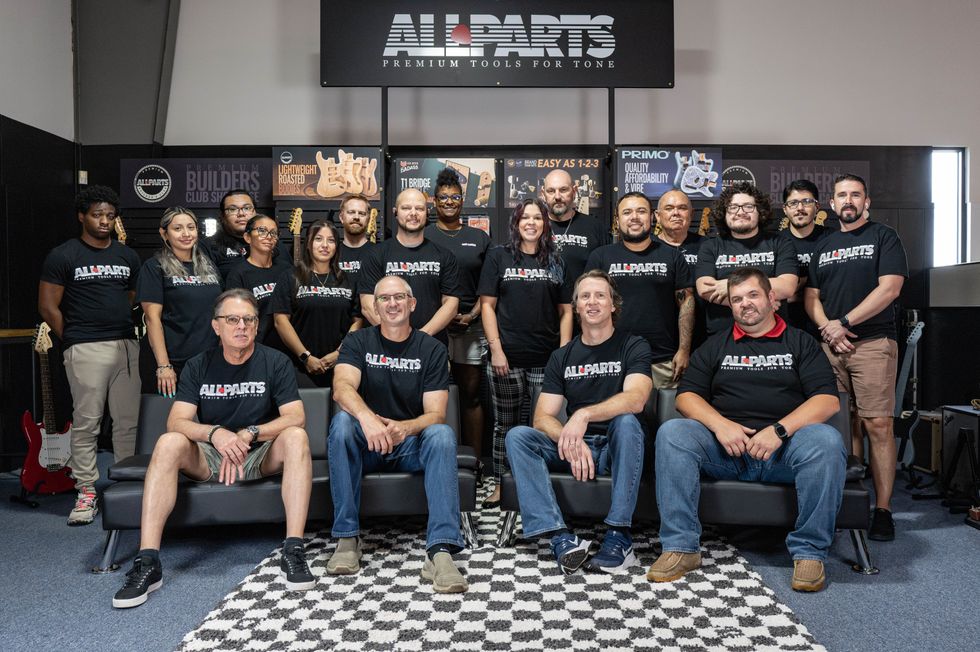 The Allparts team at their Houston warehouse, with Dean Herman in the front row, second from right.Photo by Enrique Rodriguez
The Allparts team at their Houston warehouse, with Dean Herman in the front row, second from right.Photo by Enrique Rodriguez